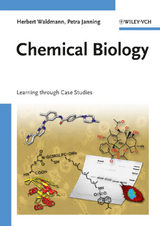Chemical Biology
Wiley-VCH (Verlag)
978-3-527-32330-2 (ISBN)
Herbert Waldmann obtained his PhD in organic chemistry from the University of Mainz in 1985 working with Professor Horst Kunz, after which he completed a postdoctoral appointment with Professor G. Whitesides at Harvard University. He was appointed as Professor of Organic Chemistry at the University of Bonn (1991), full Professor of Organic Chemistry at the University of Karlsruhe (1993), and Director at the MPI of Molecular Physiology Dortmund and Professor of Organic Chemistry at the University of Dortmund (1999). His research interests lie in the synthesis and use of small molecules in chemical biology research, the chemical biology of protein lipidation and protein microarrays. Petra Janning studied chemistry at the University of Münster, Germany, and did her PhD thesis at the Institute for Analytical Sciences in Dortmund (1995). After different positions where she worked in the area of analytical chemistry and on the borderline between chemistry and biology she joined the Max Planck Institute of Molecular Physiology, Dortmund, in the department of Professor H. Waldmann, where she is currently working. She is responsible for the bioorganic Practical Course and the analytics in the department. Her work is focused on the development of chromatographic and mass spectrometric methods used in the institute.
YEAST-BASED CHEMICAL GENOMIC APPROACHES
Introduction
The Biological Problem
The Chemical Approach
Chemical Biological Research/Evaluation - Chemogenomic Profiling: Elucidating the Mode of Action of Small Molecules
MIRCOARRAY-BASED STRATEGIES TO IDENTIFY UNKNOWN PROTEIN INTERACTIONS
Introduction
The Biological Problem
The Chemical Approach
Chemical Biological Research/Evaluation
COMPOUND COLLECTION SYNTHESIS FOR CHEMICAL BIOLOGY
Introduction
Chemical Probes - A Chemical Question with Biological Consequences
Diversity Oriented Synthesis (DOS)
Biology Oriented Synthesis (BIOS)
TARGET IDENTIFICATION AND VALIDATION OF A WNT/BETA-CATENIN PATHWAY MODULATOR
Introduction
Introduction
The Biological Problem
The Chemical Approach
Chemical Biological Research/Evaluation
ACTIVITY-BASED PROTEIN PROFILING OF CYS PROTEASES
Introduction
The Biological Problem
The Chemical Approach
Chemical Biological Research/Evaluation
THE USE OF PHOTOAFFINITY LABELING FOR THE IDENTIFICATION OF THE BINDING SITE OF THE ANTIBIOTIC LINEZOLID
Introduction
The Biological Problem
The Chemical Approach
Chemical Biological Research/Evaluation
SURGICAL STRIKES: USES OF ANALOG SENSITIVE TECHNOLOGIES TO TARGET KINASES OF INTEREST
Introduction
The Biological Problem
The Chemical Approach
Chemical Biological Research/Evaluation: ASKA Technology - Applications in Molecular Biology
MODULATION OF PROTEIN-PROTEIN INTERACTIONS BY SMALL MOLECULES
Introduction
The Biological Problem
The Chemical Approach
Chemical Biological Research/Evaluation
TARGETED PROTEIN DEGRADATION IN LIVE CELLS
Introduction
The Biological Problem
The Chemical Approach
TRAPOXIN B: FROM TOTAL SYNTHESIS TO EPIGENETICS
Introduction
The Biological Problem
The Chemical Approach
Chemical Biological Research/Evaluation
NATIVE CHEMIAL LIGATION - A TOOL FOR CHEMICAL PROTEIN SYNTHESIS
Introduction
The Synthetic Challenge
The Chemical Approach - Native Chemical Ligation
Chemical Biological Research/Evaluation - The Ras-RBD Systems
USING SPLIT INTEINS TO PREPARE SEMI-SYNTHETIC PROTEINS AND TO STUDY THE MECHANISMS OF PROTEIN TRANS-SPLICING
Introduction
The Biological Problem
The Chemical Approach
Chemical Biological Research/Evaluation
ELUCIDATION OF THE RAS CYCLE WITH SEMI-SYNTHETIC PROTEINS
Introduction
The Biological Problem
The Chemical Approach
Chemical Biological Research/Evaluation
THE STUDY OF RAB GTPASE RECYCLING USING SEMI-SYNTHETIC PRENYLATED PROTEINS
Introduction
The Biological Problem
The Chemical Approach
Chemical Biological Research/Evaluation
DEVELOPMENT OF A MODEL CANCER VACCINE CANDIDATE BASED ON THE MUCl CELLULAR SURFACE GLYCOPEPTIDE EPITOPE
Introduction
The Biological Problem
The Chemical Approach
Chemical Biological Research/Evaluation
THE INTRODUCTION OF CHEMICAL REPORTER GROUPS BY BIOORTHOGONAL LIGATION REACTIONS FOR THE IMAGING OF CELL-SURFACE GLYCANS
Introduction
The Biological Problem
The Chemical Approach
Chemical Biological Research/Evaluation
SEQUENCE SPECIFIC DNA-BINDING SMALL MOLECULES FOR PROTEIN RECRUITMENT AND MODULATION OF TRANSCRIPTION
Introduction
The Biological Problem - Targeting DNA with Small Molecules
The Chemical Approach: The Polyamide Rationale
Chemical Biological Research/Evaluation - Polyamides in Biological Applications
G-QUADRUPLEX LIGANDS AS TOOLS FOR ELUCIDATING C-MYC TRANSCRIPTIONAL REGULATION
Introduction
The Biological Problem
The Chemical Approach
Chemical Biological Research/Evaluation
"This first book to adopt a problem-based approach teaches the true basics of the subject through illustrated everyday case studies. Each chapter introduces a different biological problem taken from everyday lab work, such that students learn how to solve problems in biology by using techniques and tools taken from chemistry."
METALL (1/2 2010)
| Erscheint lt. Verlag | 18.3.2009 |
|---|---|
| Sprache | englisch |
| Maße | 170 x 240 mm |
| Gewicht | 600 g |
| Themenwelt | Naturwissenschaften ► Chemie ► Organische Chemie |
| Schlagworte | Biochemie • Biochemie u. Chemische Biologie • Biochemistry (Chemical Biology) • Chemie • Chemische Biologie • Chemistry • Organic Chemistry • Organische Chemie • Pharmaceutical & Medicinal Chemistry • Pharmaceutical & Medicinal Chemistry • Pharmazeutische u. Medizinische Chemie |
| ISBN-10 | 3-527-32330-9 / 3527323309 |
| ISBN-13 | 978-3-527-32330-2 / 9783527323302 |
| Zustand | Neuware |
| Haben Sie eine Frage zum Produkt? |
aus dem Bereich




